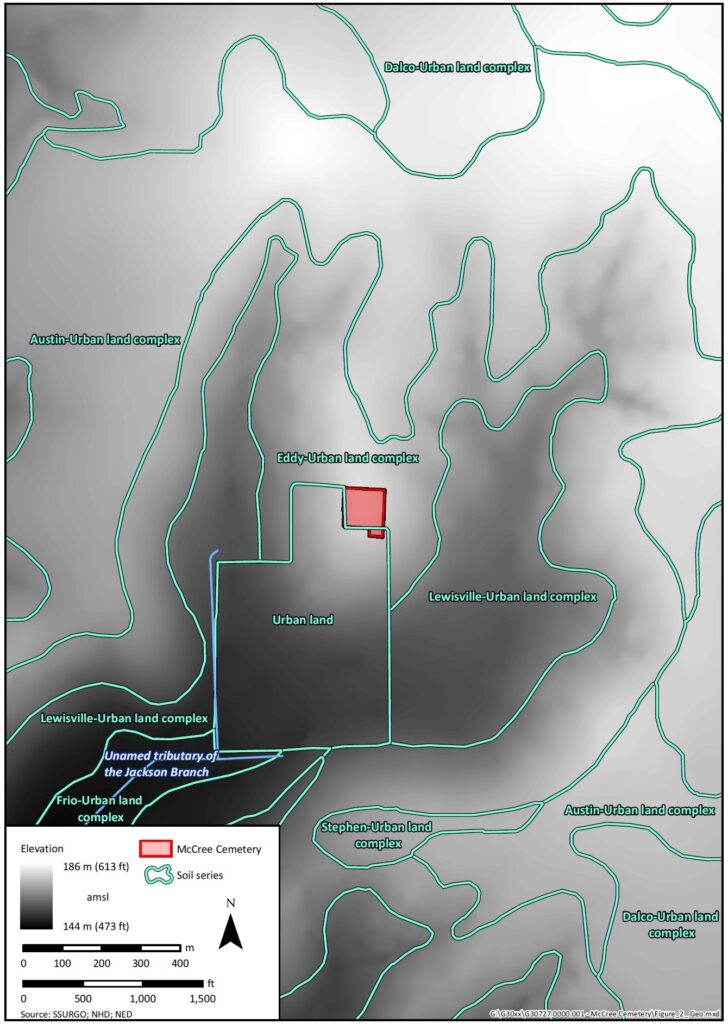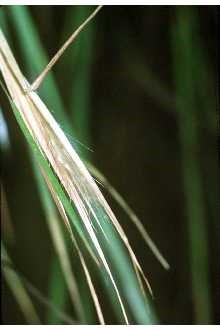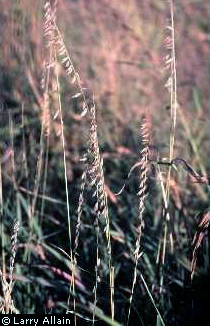Environmental Setting
The soils in this region are predominantly clay-rich vertisols derived from the in situ weathering of the underlying limestone and calcareous marl of Cretaceous-age Ozan Formation (McGowen et al. 1991). The underlying geology for McCree Cemetery is the Late Cretaceous Austin formation, consisting primarily of interbedded chalky limestone and marls. The modern soils around McCree Cemetery are mapped as Eddy-Urban land complex, Urban Land and Lewisville-Urban land complex series (Figure 9). These soils generally consist of well-drained, moderately permeable soils formed from calcareous parent material (Natural Resources Conservation Service 2015).
McCree Cemetery is located within the Blackland Prairie in North Dallas County, Texas (Griffith et al. 2004). Dallas County is located in the Texan biotic province (Blair 1950), which supports a variety of flora and fauna including native bluestem, dropseeds, eastern gamagrass, and switch grass in prairie ecosystems and bois d’arc, eastern red cedar, cottonwood, elm, oak and pecan along riparian corridors (Telfair 1999).
The cemetery plot lies at an elevation range of 177 – 181 m (580-594 ft) above mean sea level (amsl) with slopes of 0-8 percent. McCree Cemetery occupies an upland location along an unnamed tributary of the Jackson Branch, located approximately 0.2 miles [mi] (0.3 km) southeast of the cemetery boundary. Immediately surrounding the cemetery is a mix of modern residential and commercial properties with associated asphalt, cement and grassed areas.
An environmental survey was carried out by Chris Taylor (Versar’s wildlife biologist) who identified a number of different tree and plant species in the cemetery (Table 1). Only two plant species broomsedge bluestem and sideoats grama were native to the Blackland Prairie environment (Figure 10). Other species including the eastern red cedar and bois d’arc are more commonly found along riparian corridors in the Texan biotic province. A number of ornamental species suggest a more ‘managed’ introduction of plant species including iris, glossy privet, crepe myrtle, and moonglow juniper. Poverty oatgrass is the predominant species throughout the main lawn of the cemetery.
Table 1 Tree and Plant Species Located at McCree Cemetery | |||||
| Common | Scientific | Strata | Location | Cemetery | Density |
| Brier species | Smilax spp. | Herbaceous | Perimeter along fence | Both | Abundant |
| Poverty oatgrass | Danthonia spicata | Herbaceous | Main lawn | Both | Abundant |
| Possumhaw | Ilex decidua | Shrub | Perimeter along fence | Both | Abundant |
| Iris species | Iris spp. | Herbaceous | Around some graves, under trees, ornamental | European American | Common |
| Mistletoe | Phoradendron tomentosum | Herbaceous | Trees around perimeter | Both | Common |
| Broomsedge bluestem | Andropogon virginicus | Herbaceous | Along edge of main lawn | Both | Common |
| Glossy privet | Ligustrum lucidum W.T. Aiton | Shrub | Perimeter along fence | Both | Common |
| Crepe myrtle | Lagerstroemia spp. | Tree | Perimeter along fence | Both | Common |
| Eastern red cedar | Juniperus viginiana | Tree | Perimeter along fence | Both | Common |
| Sideoats grama | Bouteloua curtipendula | Herbaceous | Along edge of main lawn | European American | Common |
| Monkey grass | Liriope spp. | Herbaceous | Ornamental near some irises | European American | Sparse |
| Burr oak | Quercus macrocarpa | Tree | Near gravestones, young tree just coming up | European American | Sparse |
| Bois d’arc | Maclura pomifera | Tree | Perimeter along fence | Both | Sparse |
| Sugarberry | Celtis laevigata | Tree | Perimeter along fence | Both | Sparse |
| Red oak | Quercus buckleyi | Tree | Perimeter along fence | African American | Sparse |
| Southern catalpa | Catalpa bignonioides | Tree | Center near gravestones | African American | Sparse |
| Moonglow juniper | Juniperus scopulorum | Tree | Perimeter along fence | African American | Sparse |
| Showy windmill grass | Chloris virgata | Herbaceous | Along edge of main lawn | European American | Sparse |
| Live oak | Quercus virginiana | Tree | Perimeter along fence | African American | Sparse |


